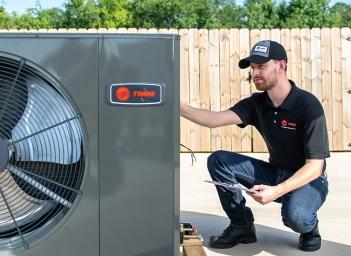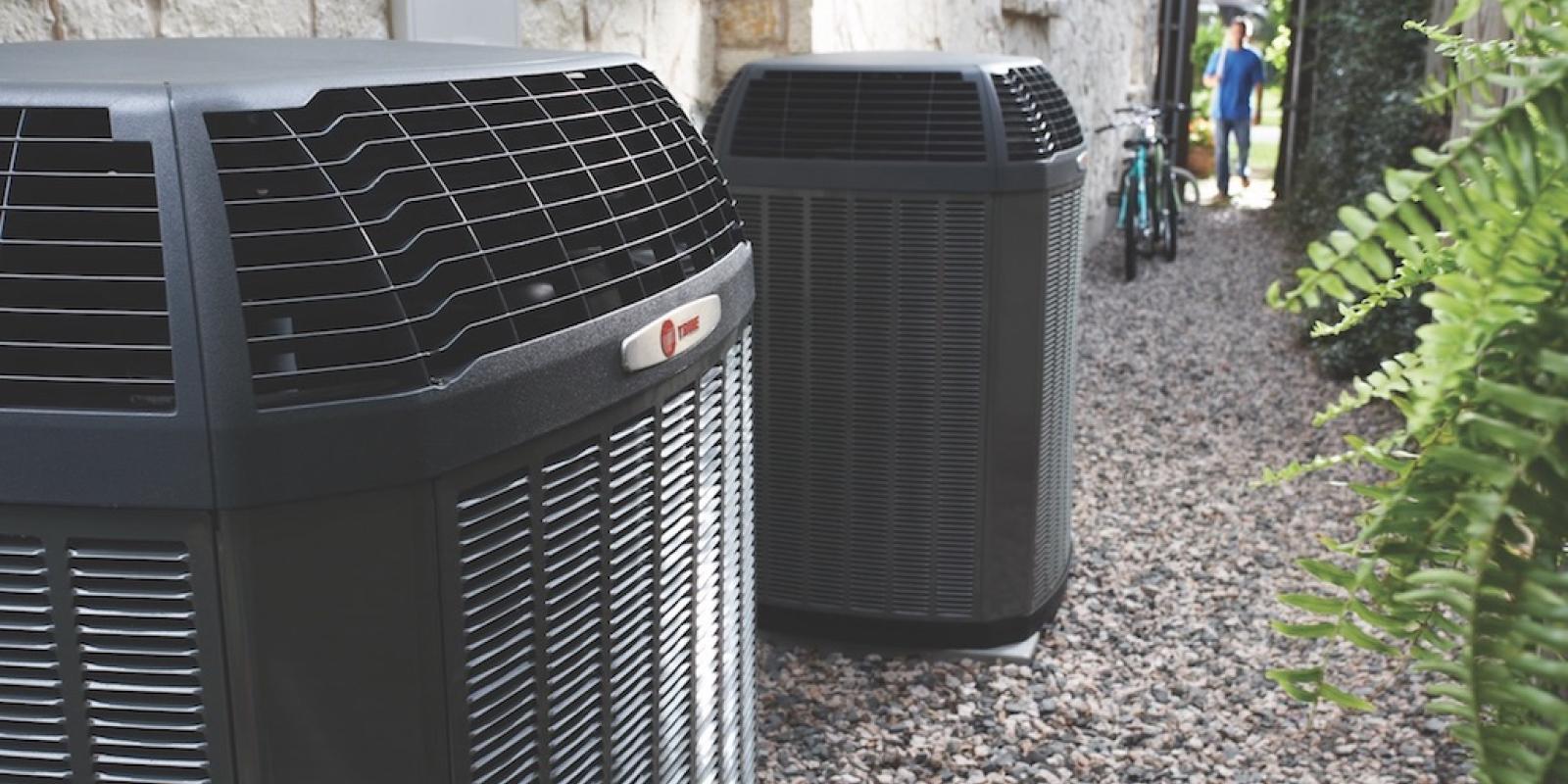Top 5 Causes of Frozen AC Coils and How to Fix Them
Learn about heat pump and air conditioner frozen coils – what causes them and what to do about them.
By Anne Fonda
Your air conditioner or heat pump cools your home, using refrigerant, two coils, and other components that work together during the refrigeration cycle. It’s a complex cycle, and if everything isn’t just right, you might find yourself Googling HVAC frozen coil, and end up here.
Find out what to do to get your cooling system working properly again.
Evaporator coil vs condenser coil
First, a quick primer on the two coils in your AC or heat pump system. The evaporator coil is the indoor coil paired with your furnace or inside your air handler. The condenser coil is located in the outdoor condenser unit - your central AC unit or heat pump. They work together to keep your home cool and comfortable.
How do you know if your AC coils are frozen?
There are several signs that you may have frozen coils, some more obvious than others. They include:
- Heat pump or AC running but not cooling
- Heat pump or AC blowing warm air
- Visible icing of the evaporator coil
- Frozen refrigerant lines and icing at the outdoor unit
- Excess condensation/puddles of water near the indoor drain pan.
Except for the obvious icing, the other indicators above may be a result of another problem with your AC or heat pump system. You will need to call an HVAC professional to get to the root of the problem.
Top causes of a frozen evaporator coil
Is your evaporator coil frozen? Want to learn why? Keep reading.
#1: Dirty air filter
A dirty HVAC air filter can restrict airflow in your HVAC system. Proper airflow is essential to provide cool air. A dirty filter can lead to a dirty evaporator coil and potentially a frozen evaporator coil.
Prevent a clogged filter by changing your air filters regularly. This should be every 30-90 days depending on the quality of the filter, how hard your system is running, if you have pets, and other factors.
#2: Dirty evaporator coil
A dirty evaporator coil is a common issue and can be a direct result of a dirty filter. The excess dust and dirt collect on the evaporator coil. Dust acts as an insulator and restricts the air circulation that the coil needs to do its job.
Prevent a dirty evaporator coil by hiring a pro instead of potentially damaging your system after watching a DIY coil cleaner tutorial. Professional HVAC maintenance can safely keep your coil clean.
#3: Blocked return vents
As we mentioned in the section on changing filters, low airflow can cause the coil to freeze. Blocked return vents result in inadequate flow over the evaporator coil. To prevent this, make sure that all return vents are clear of obstructions and debris. A common issue is when you have a couch or other piece of furniture blocking the return vent. Think about rearranging your furniture!
#4: Faulty or broken thermostat
A malfunctioning thermostat can also cause an evaporator coil to freeze. If air conditioner coils are only frozen in the morning (they froze up overnight), this may be an indication that the thermostat is to blame. If it’s not telling the AC unit to shut down as overnight temperatures fall, that’s a problem.
#5: Refrigerant leak/low refrigerant
A refrigerant leak results in low refrigerant levels/low charge which means your cooling system can’t run as efficiently as it should. If you notice an oily residue around your indoor coil or a hissing sound near the indoor coil or outdoor condenser coil, call an HVAC professional right away. You may have a refrigerant leak that should be dealt with by a trained professional. Regular HVAC maintenance can help prevent refrigerant leaks.
With proper maintenance, such as cleaning or changing the air filter and scheduling professional HVAC maintenance each spring, you can largely avoid frozen coils in the future. But what do you do if your coil is frozen? Follow these tips.
What to do if your coils are frozen
Can I run my AC with frozen coils? You SHOULD NOT DO THIS. IT MAY CAUSE IRREPARABLE HARM TO YOUR COOLING SYSTEM.
OK, sorry for shouting. If you have frozen coils, the first thing to do is turn your AC or HP unit off and allow the coil to defrost. Go to your thermostat and switch it from Cool to Off. If you have a heat pump DO NOT switch to defrost mode if the indoor coil is frozen. Defrost mode only works for removing ice from the outdoor coil that can build up when the heat pump is actively heating the house.
How do you defrost AC coils fast?
You can speed the thawing process by turning the HVAC system fan to On at your thermostat instead of Auto. The blowing fan at the furnace or air handler will help thaw out the evaporator coil. The process may take a few hours. You can also use a blow dryer on a low to medium setting, holding the hair dryer six inches away from the coil.
DO NOT CHIP AWAY AT THE ICE. This can damage the coil and cause a refrigerant leak.
While the evaporator coil is thawing, call for emergency AC repair or heat pump repair if you’re in the middle of a heat wave. If it’s evening and the temperatures are moderating, you may be able to schedule in a day or two. Just don’t turn the system back on until the coil has defrosted and you’ve changed the filter. Running the system with a frozen evaporator coil can cause irreparable damage to the condenser unit.
Top causes of a frozen condenser coil/frozen air conditioner
If you notice that your outdoor heat pump or AC unit is freezing up or the refrigerant lines are icing over, the same culprits may be behind the problem. When the evaporator coil freezes, it can’t cool properly, and the insulation effect can cause frozen coils on the cooling unit outdoors.
The steps to fix the problem are similar to those listed above. Outdoor coils on an AC unit are unlikely to freeze in the summer. But they can freeze up during heat pump heating. If it’s heating season and the heat pump outdoor coil is frozen, switch the heat pump to defrost mode if it doesn’t do so automatically. With a heat pump, the fans will automatically turn on during the defrost cycle.
Change the filter and while the outdoor unit is thawing, call for emergency AC repair if the temperatures are soaring. If it’s evening and the temperatures are moderating, you may be able to schedule in a day or two. Just don’t turn the system back on until the coils have defrosted and you’ve changed the air filter. Running the system with a frozen coil is harmful to the compressor in the outdoor unit, which is a very expensive component to replace.
Troubleshooting frozen coils
If changing the air filter or clearing the condensate drain line doesn’t solve the problem (i.e. the heat pump or AC freezes up again) it’s time to call an HVAC technician if you haven’t already. They can troubleshoot the issue and get to the root of the problem. Leave the unit off until help arrives.
When the technician arrives, they should do a full analysis, which may include:
- Taking measurements
- Connecting refrigerant gauges, checking pressures & temperatures
- Checking superheat & subcooling
- Checking airflow inside, static pressure, humidity, and more
With enough data, the system will almost diagnose itself.
Prepare for the repair or replace conversation
If you have a bad evaporator coil or condenser coil, you’ll need to have the HVAC repair or HVAC replacement conversation. Both evaporator coil replacement and condenser coil replacement can be pricey, especially if your system is no longer under warranty.
Your HVAC technician can tell you what your repair costs will be. Depending on the age of your heating and cooling system and the cost of repairs, you may want to consider HVAC replacement. Refer to our Repair or Replace Guide for more information on making this decision.
Anne Fonda
Content Writer, Trane Technologies
A Content Writer with Trane Technologies, Anne Fonda researches topics and writes for Trane® and associated residential HVAC brands. She works in collaboration with Trane Technologies subject matter experts, offering easy-to-understand, informative content on complex topics. Her goal is to help consumers make informed decisions on the products and services they need.
She has written for HVAC and other service provider websites for over 16 years. Before transitioning to web content writing, Anne had a 14-year stint as an award-winning journalist. She graduated cum laude from the University of Missouri-Columbia School of Journalism.
When she’s not working, Anne enjoys playing word games, reading, gardening, spending time with family, and visiting gardens and museums.
Expert review by Sean Goddard, Product Manager, Coils & Indoor Air Quality




